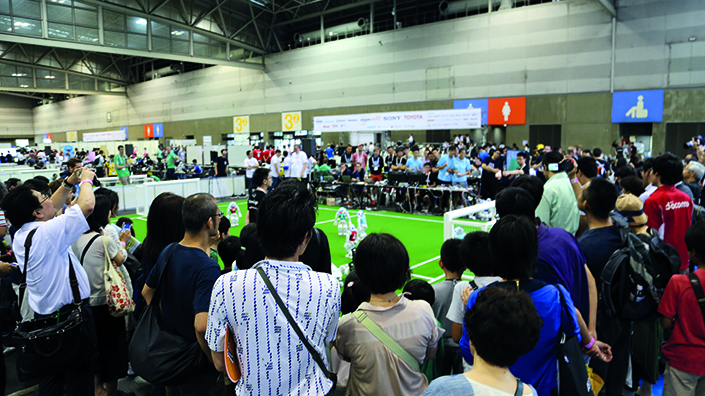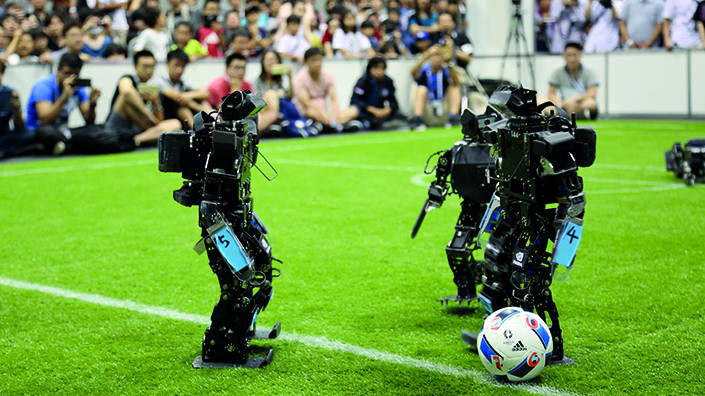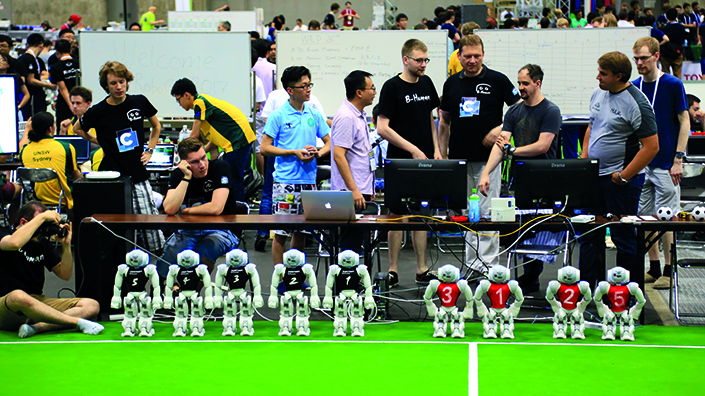When Lionel Messi, Cristiano Ronaldo and 734 other less-talented players head to Russia this month, they’ll be competing against each other for the right to lift football’s biggest prize: the FIFA World Cup. But by 2050 there could be a very different kind of opposition ready to take them on.
Robot football dates back to the mid-1990s, with the first RoboCup tournament held in 1997 – the same year IBM supercomputer Deep Blue beat grandmaster Garry Kasparov at chess. It was the first time artificial intelligence had ever got the better of a human being at the ancient board game.
That signified a change in attitude to the way robots were tested against their human counterparts, and football was seen as a step up over chess in several ways. Most crucially, football was more dynamic and played in real time, so its challenges more closely resembled those that a robot might encounter in the real world.

Close to the real world – crowds watch on at RoboCup 2017 (Credit: RoboCup)
Unlike the FIFA World Cup, RoboCup takes place every year, and from the very beginning the organisers set out a grand objective: “By the middle of the 21st century, a team of fully autonomous humanoid robot soccer players shall win a soccer game, complying with the official rules of FIFA, against the winner of the most recent World Cup.”
RoboCupSoccer is split into five categories. The top class is for humanoid, bipedal robots and is split into three sub-leagues: AdultSize, TeenSize and KidSize. AdultSize matches are one-on-one, while TeenSize teams have three players and KidSize ones have four, each performing completely autonomously but all with the same aim: to score more goals than the opposition.
The laws of the game
While the laws of human football have remained broadly the same for more than a century, the rules of RoboCup change annually – not drastically, just enough to keep the teams on their toes.
In RoboCup everything used to be brightly coloured to help the robots identify the ball and navigate around the pitch, but now the playing surface is green with white lines, while the ball has a monochrome geometric design, just like the classic Adidas balls used at World Cups in the 1970s and 1980s.
This year’s RoboCup tournament takes place in Montreal, Canada during the first full week of the human contest in Russia. Competing for the 16th time (although only for the sixth time in the KidSize sub-league) will be the Bold Hearts team from the University of Hertfordshire. They’re the longest-running RoboCup team in the UK, and one of the most successful.
Bold Hearts founder member Daniel Polani is a professor of artificial intelligence in the university’s School of Computer Science, and the current president of RoboCup. “In 1997 you basically didn’t have any humanoid robots except for in the very top labs, so people laughed at the 2050 claim,” says Polani. “We’re still a long way off but at least they can kick a ball now without falling over.”

Kid-size humanoid robots try not to fall over (and play football) (Credit: RoboCup)
To the uninitiated, that seems like a laughably low bar, but RoboCup doesn’t exist just to make robots better at football – it has a whole swathe of secondary competitions designed to advance robotics as a whole. Alongside RoboCopSoccer there’s RoboCupRescue, RoboCupIndustrial and RoboCup@Home, which set more specialised tasks for robots to complete, such as picking up objects from a moving conveyor belt and dropping them precisely into particular containers.
Again, these sound like simple tasks, but Polani explains how deceptively challenging something as simple as opening a fridge door can be for a robot: “It’s difficult because at first you have to pull hard, but the moment it becomes loose you have to stop pulling so hard, otherwise it’ll fly in your face. Humans do that without thinking about it but when you spread it out like that you realise how complicated it is.”
Several companies have already been spun off from the RoboCup competitions, including Kiva Systems, a maker of robots for warehouse transport and logistics, which Amazon bought for $775m in 2012. “RoboCup might look like blue sky research,” says Polani, “but off the back of it we’ve been participating in a European project concerning autonomous, submarine swarms for surveying the ocean floor.”
Lessons learned
RoboCupSoccer is much more than just a game. It’s helping make robots better for real-world uses. “Approaching a ball and deciding what to do with it under various circumstances is a mixture of variety and ritualised behaviour, because you do more or less the same thing with the ball every time, just under different circumstances,” Polani explains. “The lessons learned from that are hopefully transferable to how to manipulate a given object, for example a door handle.”
Since RoboCup introduced the use of artificial turf, just making the robots walk is much tougher because the ground is now uneven, but improving their ability to move around the pitch helps to prepare them for tasks in less controlled environments. “Playing football is a relatively difficult task but it has the advantage of being very structured,” explains Polani. “Homes, on the other hand, are very unstructured.”
The closest most people will get to having a robot in the home now is one of the autonomous vacuum cleaners made by companies such as iRobot, Dyson and Neato. “All houses have walls, doorways and furniture,” says Warren Hill, head of product management at Neato Robotics. “It’s the layout and floor type that differs.”
And that’s where RoboCup can help. While some of the leagues use smaller, wheeled robots, the Humanoid and Standard Platform groups all use robots that are required to walk on two legs. And, in a world where many homes have stairs, that’s a very useful skill indeed.

'Please stand for the national anthem: 00101 011 0010...' (Credit: RoboCup)
Neato’s current products, which include the Botvac D7 Connected, rely on wheels to get around your home, which restricts them to single-storey use without human intervention. They do, however, have a discovery mode, which scans their surroundings and draws an internal map of the environment.
“With that floor plan, you’re able to draw no-go lines to stop the robot from entering troublesome or untidy areas,” explains Hill. “So you get a good clean without the robot potentially getting stuck by sucking up a sock or Lego block in the kid’s room.”
This is just part of the process of teaching robots to exist in the same space as humans, something that RoboCup is working towards with its 2050 aim. Whereas the robo-footballers will have to know how much force to use when trying to dispossess their flesh-and-blood opposition without spilling any of either, home robots will need to understand a whole range of codes and conventions that humans take for granted.
“Cleaning is actually quite complicated,” says Hill. “You need to know what things are, where they belong, how delicate they are. We as humans can recognise a glass, for example, so are careful with it. A robot hand would need to be able to identify dangers and be very gentle and tactile.”
Need to communicate
And it’s not just about object recognition and environmental understanding – robots must also anticipate and interact with us. “If the robot is totally automated, how can you guarantee your floors are tidy and ready to be cleaned?” asks Hill. “Our homes are lived in and not tidy 24/7, so there almost needs to be a level of approval.” Interoperability could help this, with Neato’s robots already able to communicate with other smart home products using the web-based service IFTTT.
Teamwork is also a vital part of making robot football successful, and it’s hoped that developments here could feed into the machines that will clean our homes and take care of us in the future. “What makes teamwork easier for machines in general is that they don’t have an ego,” says the Bold Hearts’ Polani. “They’ll just do whatever serves the team best. No robot is worried about which one scores.”
Robots need to learn how to fit in around us and the complicated lives we lead. Fortunately, there’s plenty of time to solve these issues, with some major obstacles still to be overcome before a completely robo-friendly future can become a reality. “I think solving the AI problem is on the horizon, but we still have to solve the problem of materials and energy,” says Polani. “It’s tough – but it’s not impossible.”
By that time the English national team might have improved enough to genuinely challenge the world’s best themselves – just in time to get beaten by a bunch of robots.
This feature appears in the June issue of Professional Engineering magazine.
Content published by Professional Engineering does not necessarily represent the views of the Institution of Mechanical Engineers.